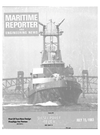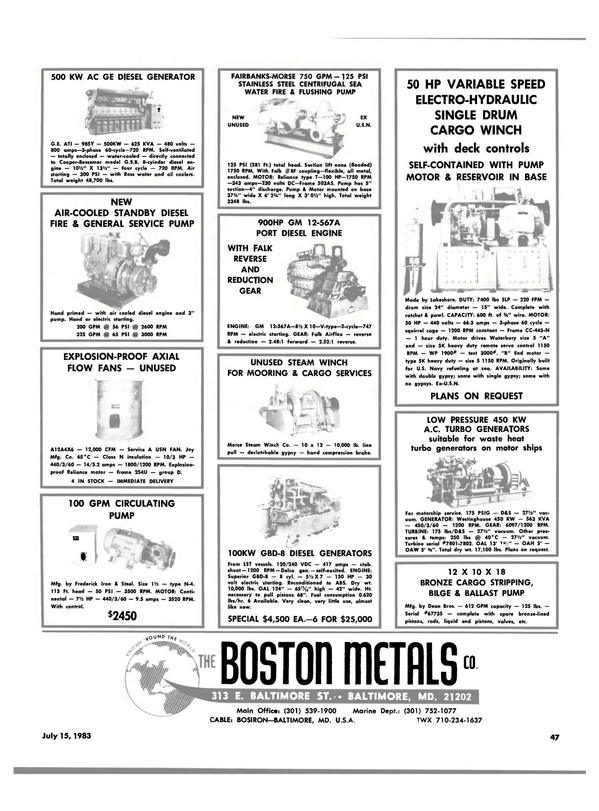
New Design For Firefighting—Pemex 652
Matsumoto Shipyards of Vancouver, British Columbia, Canada, recently delivered the 150-foot aluminum-hull fireship, the Pemex 652, to Pemex, Mexico's national oil company, for service in the extensive Gulf of Mexico oil fields owned and managed by the firm. The Pemex 652 is the first of two sister ships of a new design ordered by Pemex.
Matsumoto Shipyards has, since its inception, worked with aluminum as its chosen material. The yard has not only built a major portion of British Columbia's current fishing fleet, but landing craft for the Canadian forces as well.
Pemex chose Matsumoto to build the two 150-foot fireships because of the yard's expertise and because aluminum hulls possessed the properties the owners wanted in their huge new vessels.
The two Pemex fireships are reported to be the largest in the world. Each uses about 170 tons of plate and 30 tons of extrusions from Alcan Canada Products, Ltd.
Each vessel is 500 gross tons.
They are 150 feet in length, have a beam of 32 feet and the distance to the top monitor from the deck is 40 feet.
The twin-screw fireships are each powered by two 1725-hp MTU diesel engines. Their V-shaped hulls give them maximum speed and maneuverability. Cruising range is 250 miles and top speed is 16 knots.
The Pemex 652 is now on station, based out of Tampico, Tamps Province, Mexico. The Pemex 653 is under construction and will be based at Campeche, Camp Province.
Each vessel will remain on patrol for about a week at a time with a crew of 22 to 24 (eight officers, 16 crew).
Twin Worthington pumps, powered by separate 1200-hp MTU diesel engines are capable of drawing sea water, mixing it with a 3% AFFF foam solution, and spraying it onto offshore fires at a rate of up to 25,000 gallons per minute.
The three main monitors, or nozzles, made by the Swedish Foam Fire Extinguishing Company can each handle 5,200 gallons of water per minute. Cranes can position two more Stang monitors 75 feet above the water surface to handle 2,600 more gallons per minute, and each vessel carries 6,000 gallons of foam concentrate to mix with the water.
The hulls of the fireships are made from a special Alcan marinegrade alloy that includes magnesium and manganese. Pemex specified aluminum for the vessels because of its light weight and because the high superstructure of the vessel would have been impossible without it. Aluminum is also corrosion resistant, even in salt water, so maintenance can be kept to a minimum.
In use, the firefighting power of each vessel is controlled from the bridge which also contains the latest in navigation equipment, shipto- shore radio telephone, depth sounder, radar, loud-hailer, engine controls and hydraulic steering controls.
Schottel bow and stern thrusters enable the vessel to maneuver with ease. This permits precise station-keeping and allows the fireship's fire-fighting equipment to be quickly positioned to the best advantage.
Read New Design For Firefighting—Pemex 652 in Pdf, Flash or Html5 edition of July 15, 1983 Maritime Reporter
Other stories from July 15, 1983 issue
Content
- Future Requirements Of Coast Guard Vessels page: 6
- Dravo Awarded Navy Contract To Rehabilitate Crane At Portsmouth Yard page: 10
- DIESEL POWER REVIEW page: 12
- Dubai Dry Dock Begins Operations page: 40
- Pan-American Naval Engineers To Hold 1983 Meeting In Washington page: 40
- Beier Offers Free Brochure On Nav/Com Equipment Certified Compass Repairs page: 41
- New Engine Program For Sterndrive Packages Detailed In Free Literature page: 42
- Gulf Fleet Marine Offers 20-Page Color Brochure Describing Vessels, Service page: 42
- New Design For Firefighting—Pemex 652 page: 43
- Service Machine Group Develops Plans for a Diving Support Vessel page: 43
- Construction Underway On ACL's Five 36,000-Dwt "Leader Ships" page: 46
- Tracor Marine Announces Two Executive Appointments page: 46
- Marco To Build 75-Foot Tug For Hawaiian Island Service page: 48
- Alaska Ferry Maintenance Yard Under Construction In Ketchikan page: 58


